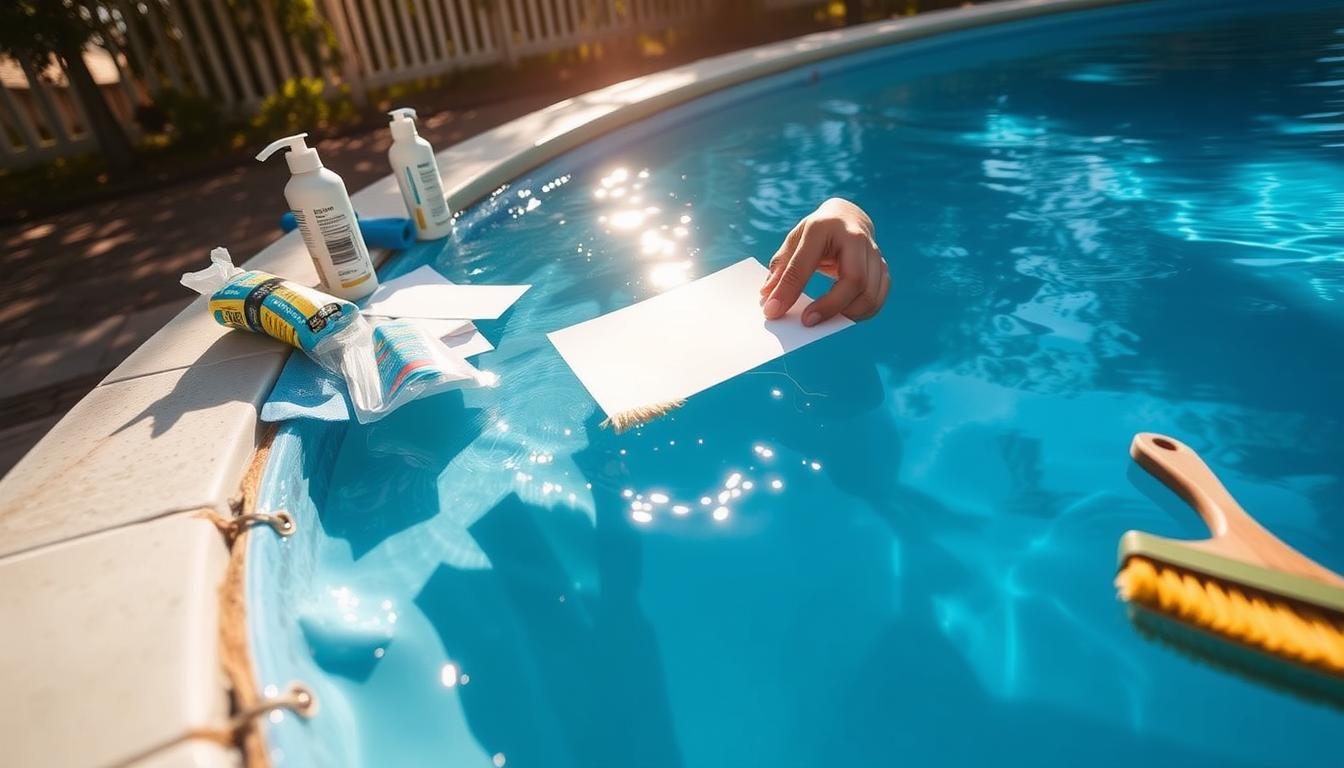
Pool repairs don’t always require draining. There are innovative methods for underwater fixes without emptying your pool. Look for water seeping out or sudden drops in levels to spot leaks.
Start with a visual check. Use food coloring or pool dye to find the exact leak spot. Pool patching is a quick, cheap DIY job that keeps your pool healthy.
This works for in-ground, vinyl liner, concrete, and fiberglass pools. Fast action is key to prevent further damage from water pressure.
Various patching methods exist. Precut patches and custom vinyl rolls differ in underwater adherence and ease of use. Pool experts can suggest the best materials for your pool type.
They’ll recommend long-lasting options for effective leak repair. These choices are tailored to your specific pool needs.
Key Takeaways
- Drain-free repairs can last several years with proper application, depending on materials used and pool condition.
- Routine checks and preventive measures are essential to avoid frequent repairs and prolong the lifespan of a pool.
- Pool patch kits usually include patches of vinyl fabric that need to be placed over the tear from the inside, as well as glue that can adhere under water.
- It is advised to wait 24-48 hours after a repair has been completed before swimming to ensure materials have fully cured.
- Consultations with pool professionals are advisable for tailored solutions for pool needs specific to local climate conditions.
Understanding Pool Repair Needs
Pool owners must know how to fix common issues efficiently. Early problem detection and drain-free repairs can save money and water. Let’s explore pool leak prevention, surface crack fixes, and tile maintenance.
Identifying Common Problems
Regular pool checks help spot issues early. Look for small surface cracks that need waterproof sealants. Untreated cracks can cause severe leaks and damage.
Loose or damaged tiles often don’t require draining the pool. Quick fixes prevent costly repairs later on.
Why Drain-Free Repairs?
Drain-free repairs save money and help the environment. Draining wastes thousands of water gallons, raising bills and straining local resources. This is crucial in drought-prone areas.
Draining can also cause structural damage due to pressure changes. Drain-free repairs are safer and more eco-friendly.
Benefits of Drain-Free Pool Repairs
Drain-free fixes cut costs and conserve water. They save on water bills and energy for heating new water. Special sealants and techniques extend pool surface life and prevent major damage.
The table below shows how durable common pool patching materials are:
| Material | Durability |
|---|---|
| Vinyl | High |
| Epoxy | Very High |
| Rubber | Moderate |
Smart pool owners use drain-free solutions when possible. This keeps pools beautiful and functional while saving money and protecting the environment.
Common Pool Issues and Drain-Free Solutions
Pool owners face many challenges in maintaining their backyard oasis. Issues like minor leaks and structural cracks can quickly worsen. Luckily, many problems can be fixed without draining the entire pool.
Repair Strategies Without Draining
Underwater adhesives and compounds are perfect for leak patching and crack filling. These products work well in submerged environments, preserving the pool’s water balance. Precut patches from vinyl repair kits can fix small punctures quickly.
For larger tears, use customizable patches cut from vinyl rolls. Underwater epoxy or rubber-based fillers work great for repairing cracks in the pool structure. These flexible sealants also address plumbing issues, ensuring a watertight seal.
List of Tools and Materials Needed
Having the right tools and materials is crucial for drain-free pool repairs. Here’s a list of items to help you fix and maintain your pool:
| Tool/Material | Purpose |
|---|---|
| Waterproof epoxy or rubber-based filler | Repairing cracks in the pool structure |
| Underwater adhesive | Fixing loose or damaged tiles |
| Flexible sealants | Addressing plumbing issues and sealing leaks |
| Vinyl patch kits | Quick and easy repair of small punctures and holes in the liner |
| Pool liner repair kits | Mending tears, cracks, and leaks in the pool liner |
| Vinyl rolls | Creating customizable patches for unique tears or larger areas |
Keep these tools and materials handy to address pool issues quickly. This approach minimizes downtime and keeps your backyard retreat in top shape. Drain-free pool repairs are efficient and effective for maintaining your pool’s health.
Step-by-Step Guide to Repair Your Pool
Fixing your pool without draining saves money and time. You can solve common pool problems with simple DIY methods. These steps will help maintain your pool’s condition for years.
DIY Friendly Techniques
Start by cleaning the damaged area with a good pool cleaner. This removes dirt and helps repair materials stick better. Next, apply underwater repair solution like waterproof epoxy to the problem spot.
These products work well under water. Let the repair set for 24-48 hours before using your pool again.
Steps and Recommendations
For pool leak repairs, first find the damage using dye tests. Clean the area well to prepare for fixing. Make a patch that fits snugly over the problem spot.
Place the patch carefully, smoothing out air bubbles. If possible, weigh down the patch for better sticking. Wait at least 24 hours before swimming or using the repaired area.
Use recommended products like pool cleaners, waterproof epoxy, or vinyl patch kits. Choose based on your pool’s specific needs.
These DIY techniques can fix your pool without draining it. Regular upkeep prevents costly repairs later. With the right tools and patience, your pool will stay in great shape.







